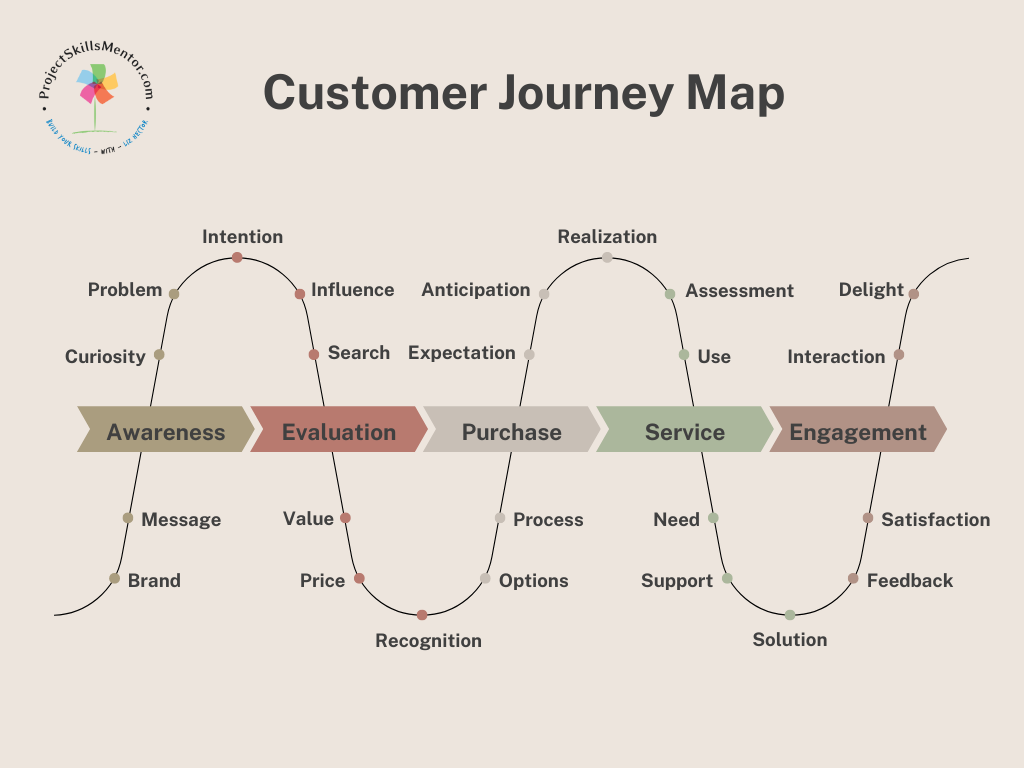How To Make Unique User Journey
Tips For Creating An Amazing Experience For Your Customers
The customer journey is the path your customers take as they engage with your brand and product.The journey starts with initial awareness, assessment if your offering is fit-for-purpose, selection your product, through to the customer engagement, feedback and return purchase cycle. No matter if your product is a service, asset, or idea, each of your customers has a journey to it.
Creating a seamless, positive customer journey is essential to driving conversions and retaining customers. However, mapping out the customer journey can seem like a daunting task. Where do you start? How do you know if you're on the right track?
Make Every Experience Count
Know your Customer
Define your customer's problem
Understand your customer's current journey
Identify each customer's touchpoints
Build a visual user journey map
Implement and track the journey's success
No matter our role or type of business, we always want to look for ways to improve the customer experience. After all, a fantastic customer experience is the key to customer loyalty and retention. But how do you create a customer experience that is unique to your brand and will keep your customers coming back for more? Doing this right can make or break a company, and it is essential to get it right.
It is also important to remember that the user journey is not just about the purchase. It is about the entire experience, from the first time they hear about your company to the after-purchase support. Every touchpoint is an opportunity to create a unique and memorable connection.
7 Ways to Make Every Customer Journey Unique
1. Put yourself in your customer's shoes
Literally, take a walk in their shoes and experience your brand or product the way they do. This will give you a better understanding of their needs and wants and how you can address them. Walk through the experience you are creating step-by-step. Whether virtual or physical. Use wonder and curiosity to help you act like a customer. Use the tools, touch the products, and place a call to the services department. Just like your customers do: view options, make decisions, and try using the tools in unexpected ways (including making 'mistakes' when using apps or other tools to see how easy it is to correct and get back on track). Try to assess what you see and feel without judgment. Next, evaluate how the experience connected with you. This process can create insights and openness. Allowing better appreciation of customer insights when feedback is received. This, in turn, will help you to connect customer input to an internal ‘call to action’.
The first step to creating an amazing customer experience is to clearly define who your customer is:
What types of customers do you have?
What do they want and need?
What are their pain points?
What are their goals?
What are their expectations?
How can you serve them better?
Align this knowledge to your company's goals. Understand how you can uniquely meet the needs of each type of customer you have. Evaluate how your product, processes, and service resonate with your customers. With this information, create a vision and action plan to make your ambition a reality.
2. Make every customer journey personal
The future of the engagement is personalization. A focus on curated services and content is growing, a point I have discussed in my Future of CX articles over the last couple of years.
Personalization is easier than ever with the help of AI. But savvy companies are going further. They are creating personalized moments which connect the customer to their brand with small gestures that make a big impact.
I have witnessed this kind of thinking in my many flights with KLM Airlines. As a frequent flyer, the onboard staff often greets me with appreciation for my loyalty. But occasionally they do even more. I have seen small gifts and champagne sent to passengers traveling for a wedding or anniversary. And my latest personal example of these acts of customer delight, was on a recent flight where I found this note on my seat.
Did I keep this note? You bet I did!
Moreover, this was not a business class ticket, this was an economy seat with a higher staff-to-passenger ratio. Making this personalized note even more impactful. Yes, it is the little things that can make customer connections deeper.
3. Ensure your customer service is top-notch
This is one of the most important things you can do to ensure your customer experience is unforgettable. Your customers should feel like they are your top priority. It’s about how your company makes your customer feel. Which is not necessarily related to your product or service. What you do may not be as important as how you do it. So consider the relationship you cultivate with your customers. And even perhaps how you help your customer with their customers.
Helping your customers with their customers or business is one of the best things any company can do to stand out from the competition. This is key in a world that is becoming more commoditized, and where sameness creates underwhelming experiences.
Also remember, top-notch service is defined by your customer, not by your company. So know what is expected, how you will deliver, and how test you are doing the right things right. This kind of focus has been proven to increase customer retention. And keeping your current customers happy, generally has a direct impact to corporate profitability.
The probability of selling to an existing customer is up to 14 times higher than the probability of selling to a new customer.
4. Simplify every process that connects your customer to your business
From branding to buying, the simpler the user journey, the better. Don't make your customers jump through hoops to purchase your product or service. Keep the process as smooth and streamlined as possible.
To help your customers engage with your organization, start by reviewing your end-to-end processes and policies. Be sure to include a review of your back-office operations in this assessment. This can help you find internal bureaucracies that can work counter to the customer outcome you want.
And, at the end of the day, it is always best to ask your front-line, customer-facing staff what they would do. They often have ideas about how to optimize customer services and internal processes. Over the years, I have come to find this part of your workforce may also be frustrated with knowing a better way, but feeling that their voices are not heard. Companies that know this, will create more autonomy for these business heroes. So learn to listen to your employees. You may find it pays off in revenue growth for businesses willing to invest in their people and trust them to do the right thing.
My experience of doing better at listening to the 'front lines' started during one of my first special projects. A large team was formed to improve a manufacturing business. As a young consultant, I was tasked with talking to staff. So, I duly interviewed the shop floor employees to ask them what could improve their work. Their ask was simple: "Give us wet/dry vacuums to clean the machines, so we can improve production cycle time and reduce our effort". The staff had made this request before, but no one seemed to be listening. I advocated for their small ask. However, the team was after the big wins. After we worked tirelessly for months and put together an amazing presentation for the Board, the results were in: we moved the outside smoker’s location, and a few other things. No idea if the shop floor was ever given the requested equipment.
5. Pay attention to the details, your Customers will, even if you don’t
It's the small things that make a big difference. Paying attention to the details will make your customer experience unique and unforgettable. This could be something as simple as remembering your customers' names or going out of your way to help them with something they are struggling with.
One of the best ways to pay attention to details is to ask. Find out what makes your company unique from your customers point of view, and then building off of that information. You may be surprised by their answers. Find ways to build what customer value into every part of your way of working. Keep the process effective and efficient to control costs. Organizations that successfully embed attention to detail in the culture, and reward staff who go the extra mile, are more likely to get the results they want without taking a big hit to their profits.
The Netflix Claridges documentary proves this point. Focusing on details and personal pride in every staff member's role enables employees to create the right atmosphere for each guest. This is built into their way of working, but more importantly, part of their culture. The ability of staff to consider, and act on, the user journey for each guest is one of their most impactful unique selling points. Find ways to set yourself apart from the rest. Your customers will remember you for it.
6. Appreciate that happy Employees can make happier Customers
Businesses, organizations, departments, and project teams that work to build connections within their ranks, and externally, create a better work environment. The natural ecosystem of employees and stakeholders, including customers, can be made happier by these very connections. Encounters with proactive, productive, positive people can create a ripple effect - one that your customers will feel, even if they never visit a store or office.
Community engenders loyalty and increases human connections. Which, in turn, improves more moments of happiness. Just take a look at the January issue of Time Magazine dedicated to the topic. Organizations that focus on being a happier workplace get measurable payoffs. Employees are more productive, customers, as a group, are happier, and the business does better.
Firms with high employee satisfaction outperform their peers by 2.3% to 3.8% per year in long-run stock returns – 89% to 184% cumulative.
If your organization respects that hard-won level of customer connection, you will continue to deepen the relationship with outreach to that customer. This can be through customer surveys, social media monitoring, and customer service software.
But the most powerful form of feedback is from your valued customers directly. Employee-Customer connections matter. Foster happiness, trust, and connectedness with all of your employees, but especially with customer facing staff. This will create a virtuous cycle of relationship building with your best customers and employees to care and are empowered to act on the customer and companies behalf.
Making an effort to create personal connection with those that know and value your product has the benefit of keeping customers you have, and finding out how to attract new customers. No market research can be more helpful than hearing the views of those who have already experienced your company’s customer journey. Doing this is how many successful company’s stay successful.
7. Implement, Track and - look for ‘happy accidents’?
Remember the KLM and Claridges examples? Once you know your customers optimized journey implement it and track results. But make room for happy accidents - when one-off needs occur, let the processes and options flex to address them.
Have you seen the ‘home videos’ on YouTube showing how delivery people adjust and interact with porch surprises (cookies left out for them) and obstacles (a new dog). Their reactions cannot be scripted, and not every situation can be foreseen. But their human, funny and often heartwarming interactions cause customer delight. And this is often not directly related to the product delivered or the company behind that product. But it is part of the customer experience. So embrace the unexpected with a few principals for the black swans of life:
Be Customer-Centric by design
Give your employees license to act
Listen to your Customers
Build positive connections, relationships and community across your business eco-system
The best customer experiences create an emotional connection. Make your customer feel important to your business, valued for who they are, and appreciated.
Building customer journeys to understand your customer and exceed their expectations is one of the most important steps to creating a relationship with your customers. Learning to empower your people will make them, and the customers they serve, feel special (even part of your company's inner circle).
Emotional connection, loyalty, and trust are the building blocks of a long-term customer relationship, which should be one of your company’s most valuable assets.





